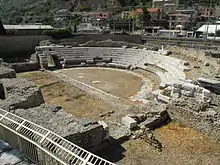Intimilii
The Intimilii or Intemelii were a Ligurian tribe dwelling on the Mediterranean coast, around present-day Ventimiglia, during the Iron Age and the Roman period.
Name
They are mentioned as Intimilii by Caelius Rufus (49 BC),[1] Intemelii by Livy (late 1st c. BC),[2] and as Intemélioi (Ἰντεμέλιοι) by Strabo (early 1st c. AD).[3]
The modern city of Ventimiglia, attested as oppidum Album Intimilium by Pliny (1st c. AD) and as Álbion Intemélion (Ἄλβιον Ἰντεμέλιον) by Strabo, is named after the Ligurian tribe.[4]
Geography

The Intemelli dwelled on the Mediterranean coast, east of Mont Agel around the town of Album Intimilium (modern Ventimiglia).[5] Their territory was located east of the Vediantii, west of the Ingauni, and south of the Epanterii.[6]
Their chief town was known as Album (or Albium) Intimilium, and later as Albintimilium. Mentioned as an oppidum by Pliny and as a municipium by Tacitus, the settlement knew devastations through the supporters of Otho in 69 AD.[7] Patrizia de Bernardo Stempel has proposed to interpret Album Intimilium as stemming from *Albion Vindi-mell-ion ('the white-hill town').[8]
History
In 180 BC, the consul Aulus Postumius Albinus, after vanquishing the nearby mountain Ligurians, sent ships to reconnoiter the shores of the Intemelii and Ingauni, which suggests that they were regarded as a potentially hostile tribe by Rome.[9]
In March 49 BC, during the Civil War, Caelius Rufus reported to his friend Cicero that Demetrius, a garrison-commander from Pompey's army, had been bribed by one faction among the Intimilii to murder the local notable and former host of Caesar named Domitius. The people of Intimilium took the arms and Caelius was forced to come there with some cohorts through the snow to restore order.[10]
Be that as it may, what have I ever done to deserve the bad luck of this compulsory journey back to the Alps? The Intimilii are up in arms, for no very momentous reason: Demetrius, Bellienus' slave boy, being stationed there with a detachment of troops, was bribed by the opposite party to seize and strangle one Domitius, a notable of the district and a host of Caesar's. The people rushed to arms. Now I have to trudge there through the snow with [lac.] cohorts. You’ll remark that the Domitii are coming to grief all along the line. Well, I could wish our scion of Venus had shown as much spirit in dealing with your Domitius as Psecas' offspring showed with this one!
References
- Cicero. Epistulae ad Familiares, 149 (VIII.15).
- Livy. Ab Urbe Condita Libri, 40:41:6.
- Strabo. Geōgraphiká, 4:6:2.
- Giannattasio 2007, p. 136.
- Barruol 1969, p. 366.
- Talbert 2000, Map 16: Col. Forum Iulii-Albingaunum.
- Salomone Gaggero 2006.
- de Bernardo Stempel 2006, p. 46.
- Dyson 1985, p. 103.
- Millar, Fergus (1984). "The Mediterranean and the Roman Revolution: Politics, War and the Economy". Past & Present (102): 3–24. ISSN 0031-2746. JSTOR 650758.
Primary sources
- Cicero (2001). Letters to Friends. Loeb Classical Library. Translated by Shackleton Bailey, D. R. Harvard University Press. ISBN 978-0674995895.
- Livy (2019). History of Rome. Loeb Classical Library. Translated by Yardley, J. C. Harvard University Press. ISBN 978-0674992566.
- Strabo (1923). Geography. Loeb Classical Library. Translated by Jones, Horace L. Harvard University Press. ISBN 978-0674990562.
Bibliography
- Barruol, Guy (1969). Les Peuples préromains du Sud-Est de la Gaule: étude de géographie historique. E. de Boccard. OCLC 3279201.
- de Bernardo Stempel, Patrizia (2006). "From Ligury to Spain: Unaccented *yo > (y)e in Narbonensic votives ('gaulish' DEKANTEM), Hispanic coins ('iberian' -(sk)en) and some theonyms". Palaeohispanica. 6: 45–58. ISSN 1578-5386.
- Dyson, Stephen L. (1985). The Creation of the Roman Frontier. Princeton University Press. ISBN 978-1-4008-5489-9.
- Giannattasio, Bianca Maria (2007). I liguri e la Liguria: storia e archeologia di un territorio prima della conquista romana. Longanesi. ISBN 978-88-304-2123-3.
- Salomone Gaggero, Eleonora (2006). "Album Intimilium". Brill’s New Pauly. doi:10.1163/1574-9347_bnp_e113380.
- Talbert, Richard J. A. (2000). Barrington Atlas of the Greek and Roman World. Princeton University Press. ISBN 978-0691031699.
